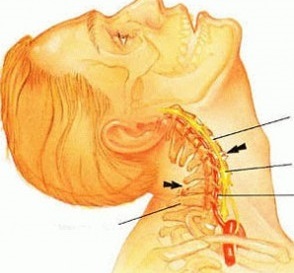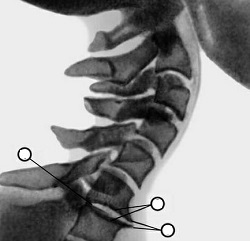Osteochondrosis is a disease of the skeletal system that is characterized by changes in cartilage tissue. As a result of the development of disease, a person's work capacity is reduced, impaired blood circulation and integrity of the vertebral disc. Disease develops as a result of obesity, physical inactivity, frequent time at the computer or driving a car.
symptoms of cervical osteochondrosis
Osteochondrosis of the cervical spine, as it develops, is characterized by the following symptoms:

neck pain with cervical osteochondrosis
- Headaches of a persistent nature. Patients with osteochondrosis usually experience headaches that are aggravated by a sharp turn of the neck or sudden movement of the head.
- Neck pain that can radiate to the shoulder area. Appears often in the morning, immediately after sleep, after the neck muscles have warmed, completely subsides or disappears.
- characterized by cervical lumbago, severe pain in the neck, tightening of muscles in the affected area, and limited mobility.
- pain in the sternum or gallbladder. Patients most often suspect that they have a deformity of the cardiovascular system, but taking nitroglycerin does not relieve pain. When cervical osteochondrosis is manifested by pain in the sternum. Patients complain of a decrease in muscle strength in the arms.
- In almost all patients with osteochondrosis, you may hear a characteristic deficiency and eccentricity if you ask a person to tilt his head in different directions.
- hoarseness of voice.
- Osteochondrosis of the neck may be manifested by numbness of the tongue, a symptom resulting from compression of the nerves and vessels located next to the intervertebral disc.
- Increase in blood pressure.
- osmosis, loss of muscle strength in organs.
The cause of the above symptoms is damage to the connective tissue and intervertebral discs with their subsequent deformation. As a result of pathological processes, the disc becomes overexploited with bone structures, the formation of osteophytes, which make blood vessels and nerve pathwaysSqueeze and cause harm.
stages of the disease
Osteochondrosis of the cervical spine develops in several stages. The more the disease of the patient grows, the more symptoms are formed, the more serious are the complications of the disease.
Grade 1 cervical osteochondrosis is characterized by damage to the nucleus pulposus of the intervertebral disc. When metabolism is disturbed in the body, the nucleus pulposus, which is a structure of biopolymer compounds, is destroyed. First, it loses water. Is, dries slowly, and therefore decreases in size. Its strength decreases significantly and it becomes more difficult for the spine to withstand physical activity. At this stage of the disease, a person experiences painDoes not feel, does not ask for medical help. If you start identifying osteochondrosis at this stage, the patient will not need drug treatment.
degree 2 cervical osteochondrosis is characterized by damage to the annulus fibros in the intervertebral disc. Cracks and tears appear on the surface of the disc as a result of strong and uneven loads on the bone. The fact that the annulus fibros is thinned, The nuclei are squeezed completely into the resulting tears and cracks, causing them to expand. As the disc grows in size, the disc begins to spread beyond the edges of the vertebrae. This phenomenon is called disc protrusion. . 2-degree cervical osteochondrosis is the stage of disease at which a person feels pain for the first time.
Grade 3 cervical osteochondrosis is characteristic of the formation of a hernia. The annulus fibrose not only becomes thin, but ruptures, so the nucleus pulposus "flows" into the subglottic space, forming a herniated disc. As a result of growth, all the surrounding tissue suffers - the ligaments and muscles, nerves and blood vessels.

Over time, the skeletal system of the vertebrae changes: the vertebral edges change in shape, get ribbed and even sharpened. The surrounding bone system changes. The muscles contract involuntarily, thereby limiting spinal mobility. All nerve fibers running through the backbone are impaired, the conduction of nerve impulses from the brain to organs and tissues is impeded. This is important. That osteochondrosis symptoms appear depending on the location of osteochondrosis.
Grade 4 cervical osteochondrosis is characterized by degenerative spinal reconstruction. After destructive processes in the body, recovery processes begin to prevail. The duration of the fourth phase is approximately one year. During this time, the bone in the deformed vertebraeThe nature of the increase changes. The bone begins to increase in width, causing the area of the vertebrae to increase. Such an increase in therapy is called osteophytes. Thanks to them, the mobility of the injured spine decreases, and itsDestruction processes are suspended. Over time, the motionless vertebrae become completely a stationary bone column.
And if the pain syndrome subsides, the pinched nerves and blood vessels remain in place, squeezing them not only by the discs and vertebrae, but also by the osteophytes formed. To prevent the consequences of disease suchProcedures should be treated appropriately.
Complications of Cervical Osteochondrosis
The main consequences of the development of cervical osteochondrosis are:
- vascular disorder (compression of arteries);
- formation of hernias of varying severity;
- spinal cord injury;
- osteophyte formation;
- Restricted mobility of the spinal column.
What complications can cause cervical osteochondrosis? The most dangerous result is the deterioration of the blood supply to the brain. As a result of squeezing the arteries, less blood enters the brain, and the gray matter is poorly supplied with oxygen.
If a patient develops a vertebral artery syndrome - when the main blood pathway is pinned to the brain, the person suffers from dizziness, fainting.
In addition to impaired consciousness, there is loss of vision and hearing in patients with osteochondrosis of the cervical spine. In addition to the numbness of the organs, it is possible to develop a syndrome of dupitrain, characterized by stiffness of the hands. As a result of development, mobility of the fingers is lost.
Hypertension and vegetative-vascular dystonia (VVD) are often considered complications. A cosmetic defect that appears as a result of the development of osteochondrosis is the formation of the back of the head (the "mound" of cartilage tissue).
treatment methods
Treatment options for cervical osteochondrosis depend on the stage of the disease. Medical treatment includes non-steroidal medications, analgesics, and antispasmodics in prescription. The dose of the drug is adjusted at the doctor's discretion.
Physical therapy is often prescribed to treat osteochondrosis of cervical vertebrae. With the help of exercise, you can not only relieve pain, but also reduce inflammation, strengthen your back muscles. , And may reduce the risk of complications.
Massage has a general strong effect. After a course of therapy, a patient with osteochondrosis will lose tension and pain, and the blood supply will increase.
When medication is not helpful, doctors have to prescribe surgery. During surgery, doctors remove parts of the intervertebral disc that constrict the nerve roots.
The best treatment is a combination of several methods. Medical treatment should be combined with massage, physiotherapy practice, and gymnastics.
Some doctors believe that acupuncture and herbal remedies are an effective method of treatment.
prevention
To reduce pain and prevent the development of osteochondrosis of the cervical spine, you can use simple methods. To begin, each person must be in a constant position that is on the spinal column. Relieve load. You should remember about exercises that knead muscles and support metabolic processes in the spine. To get positive results, you should follow the recommendations given by the doctor.
Main Recommendations:
- Distribute physical activity evenly over the spinal column. To do this, limit vertical loads, avoid sudden movements and exercises that can damage the spinal column. Avoid falling or jumping from great height.
- Do not carry heavy objects by extending your arms in front of you. Before lifting an object from the floor, you should not bend forward, but must sit down.
- Do not move objects in one hand, it is advisable to distribute the load on both limbs. If this is not possible, you should keep the load in a suitcase on wheels or a backpack.
- If you need to lift heavy loads, you should put on a wide belt or buy a special corset before working.
- Wear comfortable shoes.
- The best prevention of the disease is swimming, regular gymnastics, taking a shower by contrast.
- Stressful situations should be avoided.
- You need to remember the rules of a balanced diet.
- Get rid of bad habits.
It is necessary to understand that to prevent a disease it is very easy to maintain it for a long time and continuously. If the operation is not required in the early stage of the disease, then in the later stages of osteochondrosis the need for surgical intervention. it occurs.

















































